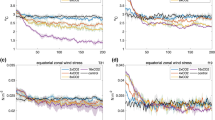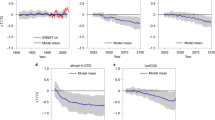Abstract.
We investigate the response of the tropical Pacific climate system to a tripling of CO2 in a coupled atmosphere–ocean model. Equilibrium asynchronous coupling (EAC) is used to diagnose the climatic forcing mechanisms. Our results corroborate those from most other coupled GCMs, which generally simulate an El Niño-like mean climate state under increased CO2. This pattern is characterized by enhanced warming of the ocean surface in the equatorial Pacific in conjunction with a reduction in the zonal SST gradient, stronger atmospheric convection and precipitation in the central equatorial Pacific, a stronger Subtropical Westerly Jet, and a deepened wintertime Aleutian Low in association with a PNA-like geopotential pattern aloft. We show that these climate changes are triggered by a weakening of the tropical Walker Circulation, which leads to weaker surface easterly winds along the equator and therefore less oceanic upwelling. Furthermore, the main El Niño-like atmospheric anomalies do not depend critically on the existence of an east-west equatorial gradient either in the simulated modern SSTs or in the SST anomalies under increased CO2. Regardless of the details of the SST boundary conditions, the atmosphere seems to respond similarly to a CO2 warming perturbation and in a manner that favors the evolution of the climate system toward an El Niño-like state. An enhanced meridional atmospheric circulation in the Pacific is linked to increased convection along the ITCZ, coinciding with subtropical anomalies of higher surface pressure and stronger subsidence aloft. This anomalous surface pressure pattern is much more pronounced in the Northern Hemisphere, presumably due to a PNA-like atmospheric teleconnection. These surface pressure anomalies produce a stronger meridional outflow of wind toward the equator and weaker easterly winds along the equator. The weaker equatorial easterlies reduce oceanic upwelling in the central and eastern equatorial Pacific, thereby promoting a reduced east-west SST gradient and a maximum warming in the central equatorial Pacific (around 140–170°W).
Similar content being viewed by others
Author information
Authors and Affiliations
Additional information
Electronic Publication
Rights and permissions
About this article
Cite this article
Vavrus, .S., Liu, .Z. Toward understanding the response of the tropical atmosphere–ocean system to increased CO2 using equilibrium asynchronous coupling. Climate Dynamics 19, 355–369 (2002). https://doi.org/10.1007/s00382-002-0232-1
Received:
Accepted:
Issue Date:
DOI: https://doi.org/10.1007/s00382-002-0232-1




